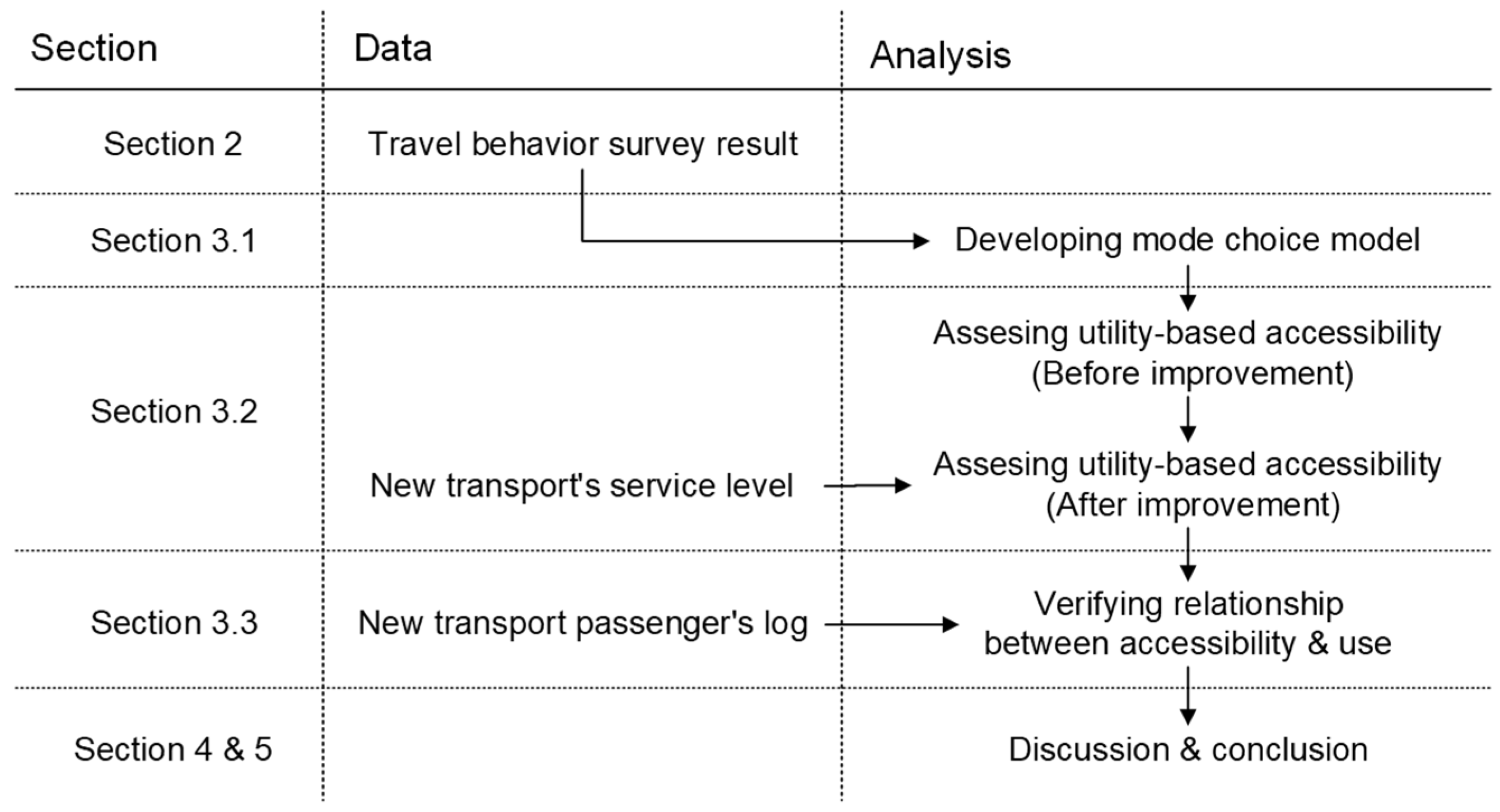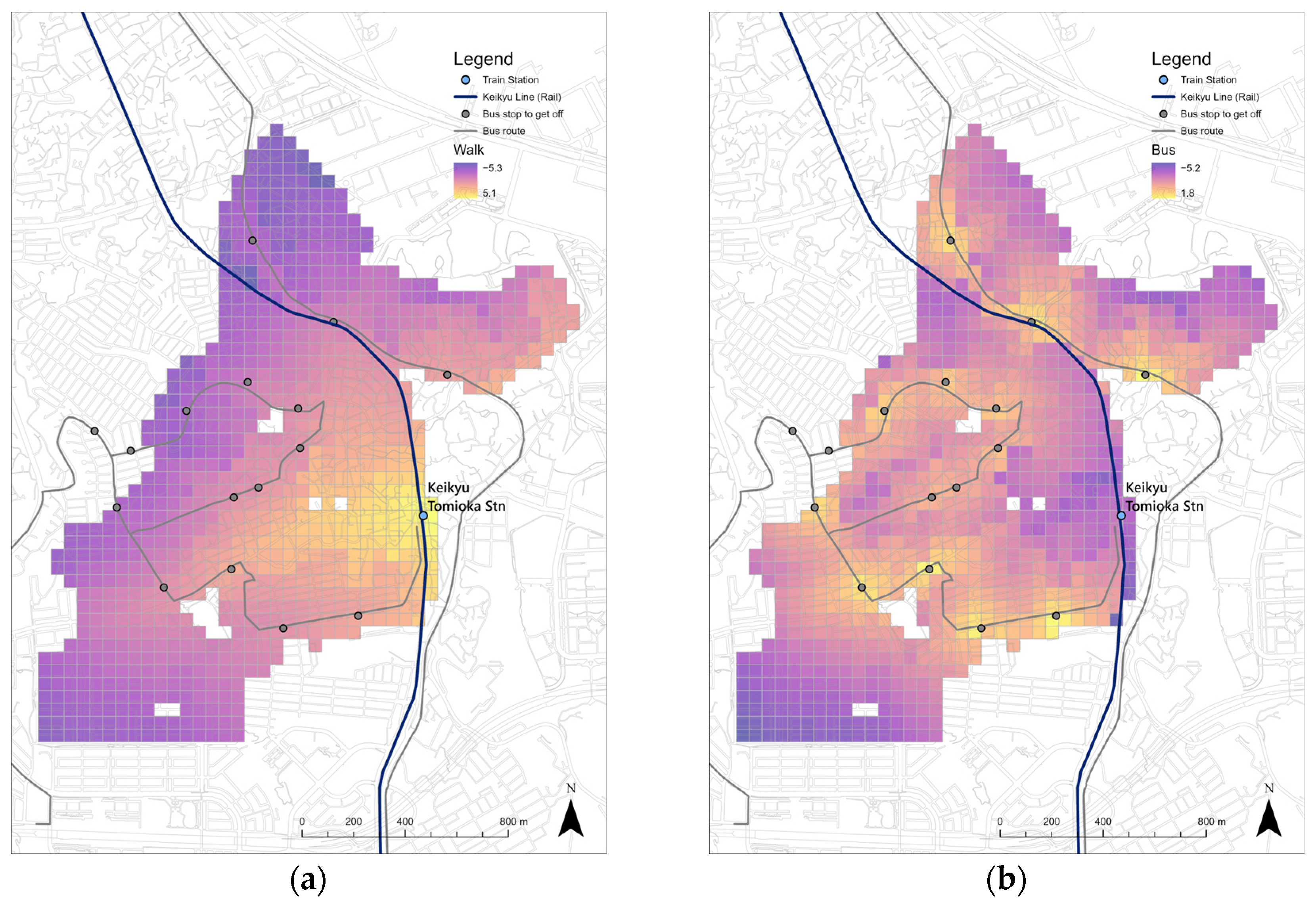Assessment of the Improvement of Public Transport in Hillside Cities Considering the Impact of Topography on Walking Choices
Abstract
1. Introduction
2. Methods
3. Results
3.1. Topographic Impacts on Travel Mode Choice
3.1.1. Developing Model Inputs
3.1.2. Parameter Estimation Results
3.2. Assessing Utility-Based Accessibility Index
3.3. Relationship between Accessibility Improvements and Use of New Service
4. Discussion
5. Conclusions
Author Contributions
Funding
Institutional Review Board Statement
Informed Consent Statement
Data Availability Statement
Acknowledgments
Conflicts of Interest
Appendix A
References
- Jette, M.; Sidney, K.; Blumchen, G. Metabolic Equivalents (METs) in Exercise Testing, Exercise Prescription, and Evaluation of Functional-Capacity. Clin. Cardiol. 1990, 13, 555–565. [Google Scholar] [CrossRef] [PubMed]
- Ainsworth, B.E.; Haskell, W.L.; Herrmann, S.D.; Meckes, N.; Bassett, D.R.; Tudor-Locke, C.; Greer, J.L.; Vezina, J.; Whitt-Glover, M.C.; Leon, A.S. 2011 Compendium of Physical Activities: A Second Update of Codes and MET Values. Med. Sci. Sport. Exerc. 2011, 43, 1575–1581. [Google Scholar] [CrossRef] [PubMed]
- Minetti, A.E.; Moia, C.; Roi, G.S.; Susta, D.; Ferretti, G. Energy cost of walking and running at extreme uphill and downhill slopes. J. Appl. Physiol. 2002, 93, 1039–1046. [Google Scholar] [CrossRef] [PubMed]
- Ferrer, S.; Ruiz, T. The impact of the built environment on the decision to walk for short trips: Evidence from two Spanish cities. Transp. Policy 2018, 67, 111–120. [Google Scholar] [CrossRef]
- Nordbakke, S. Capabilities for mobility among urban older women: Barriers, strategies and options. J. Transp. Geogr. 2013, 26, 166–174. [Google Scholar] [CrossRef]
- Larranaga, A.M.; Arellana, J.; Rizzi, L.I.; Strambi, O.; Cybis, H.B.B. Using best-worst scaling to identify barriers to walkability: A study of Porto Alegre, Brazil. Transportation 2019, 46, 2347–2379. [Google Scholar] [CrossRef]
- Ruiz-Padillo, A.; Oestreich, L.; Torres, T.B.; Rhoden, P.S.; Larranaga, A.M.; Cybis, H.B. Weighted assessment of barriers to walking in small cities: A Brazilian case. Transp. Res. Part D-Transp. Environ. 2022, 109, 103392. [Google Scholar] [CrossRef]
- Rahman, A. A GIS-based, microscale walkability assessment integrating the local topography. J. Transp. Geogr. 2022, 103, 103405. [Google Scholar] [CrossRef]
- Paez, A.; Anjum, Z.; Dickson-Anderson, S.E.; Schuster-Wallace, C.J.; Ramos, B.M.; Higgins, C.D. Comparing distance, time, and metabolic energy cost functions for walking accessibility in infrastructure-poor regions. J. Transp. Geogr. 2020, 82, 11. [Google Scholar] [CrossRef]
- Stinson, M.A.; Bhat, C.R.; Trb. Commuter bicyclist route choice—Analysis using a stated preference survey. Transp. Res. Rec. 2003, 1828, 107–115. [Google Scholar] [CrossRef]
- Lu, W.; Scott, D.M.; Dalumpines, R. Understanding bike share cyclist route choice using GPS data: Comparing dominant routes and shortest paths. J. Transp. Geogr. 2018, 71, 172–181. [Google Scholar] [CrossRef]
- Broach, J.; Dill, J.; Gliebe, J. Where do cyclists ride? A route choice model developed with revealed preference GPS data. Transp. Res. Part A-Policy Pract. 2012, 46, 1730–1740. [Google Scholar] [CrossRef]
- Guo, Z. Does the pedestrian environment affect the utility of walking? A case of path choice in downtown Boston. Transp. Res. Part D-Transp. Environ. 2009, 14, 343–352. [Google Scholar] [CrossRef]
- Halefom, T.H.; Pullar, D.; Pojani, D.; Asamoah, E.F. How much traffic stress can cyclists endure? Case Stud. Transp. Policy 2022, 10, 2251–2261. [Google Scholar] [CrossRef]
- Clifton, K.J.; Singleton, P.A.; Muhs, C.D.; Schneider, R.J. Development of destination choice models for pedestrian travel. Transp. Res. Part A-Policy Pract. 2016, 94, 255–265. [Google Scholar] [CrossRef]
- Meeder, M.; Aebi, T.; Weidmann, U. The influence of slope on walking activity and the pedestrian modal share. Transp. Res. Procedia 2017, 27, 141–147. [Google Scholar] [CrossRef]
- Parkin, J.; Wardman, M.; Page, M. Estimation of the determinants of bicycle mode share for the journey to work using census data. Transportation 2008, 35, 93–109. [Google Scholar] [CrossRef]
- Rietveld, P.; Daniel, V. Determinants of bicycle use: Do municipal policies matter? Transp. Res. Part A-Policy Pract. 2004, 38, 531–550. [Google Scholar] [CrossRef]
- Vandenbulcke, G.; Dujardin, C.; Thomas, I.; de Geus, B.; Degraeuwe, B.; Meeusen, R.; Panis, L.I. Cycle commuting in Belgium: Spatial determinants and ‘re-cycling’ strategies. Transp. Res. Part A-Policy Pract. 2011, 45, 118–137. [Google Scholar] [CrossRef]
- Rodriguez, D.A.; Joo, J. The relationship between non-motorized mode choice and the local physical environment. Transp. Res. Part D-Transp. Environ. 2004, 9, 151–173. [Google Scholar] [CrossRef]
- Nguyen, T.A.H.; Chikaraishi, M.; Seya, H.; Fujiwara, A.; Zhang, J.Y. Elderly’s heterogeneous responses to topographical factors in travel mode choice within a hilly neighborhood: An analysis based on combined GPS and paper-based surveys. Eur. J. Transp. Infrastruct. Res. 2017, 17, 411–424. [Google Scholar]
- Winters, M.; Brauer, M.; Setton, E.M.; Teschke, K. Built Environment Influences on Healthy Transportation Choices: Bicycling versus Driving. J. Urban Health-Bull. N. Y. Acad. Med. 2010, 87, 969–993. [Google Scholar] [CrossRef]
- Nielsen, T.A.S.; Olafsson, A.S.; Carstensen, T.A.; Skov-Petersen, H. Environmental correlates of cycling: Evaluating urban form and location effects based on Danish micro-data. Transp. Res. Part D-Transp. Environ. 2013, 22, 40–44. [Google Scholar] [CrossRef]
- Braun, L.M.; Rodriguez, D.A.; Cole-Hunter, T.; Ambros, A.; Donaire-Gonzalez, D.; Jerrett, M.; Mendez, M.A.; Nieuwenhuijsen, M.J.; de Nazelle, A. Short-term planning and policy interventions to promote cycling in urban centers: Findings from a commute mode choice analysis in Barcelona, Spain. Transp. Res. Part A-Policy Pract. 2016, 89, 164–183. [Google Scholar] [CrossRef]
- Cervero, R.; Duncan, M. Walking, bicycling, and urban landscapes: Evidence from the San Francisco Bay area. Am. J. Public Health 2003, 93, 1478–1483. [Google Scholar] [CrossRef]
- Muller, S.; Mejia-Dorantes, L.; Kersten, E. Analysis of active school transportation in hilly urban environments: A case study of Dresden. J. Transp. Geogr. 2020, 88, 102872. [Google Scholar] [CrossRef]
- Terayama, K.; Odani, M.; Iwasaki, K. Study on Evaluation of Convenience of Access to the Nearest Railway Station by Residents in Housing Development Areas in the Suburbs of Kobe City in Japan-Using Utility-Based Accessibility Measures. J. East. Asia Soc. Transp. Stud. 2015, 11, 379–391. [Google Scholar] [CrossRef]
- Kidokoro, T.; Peterson, S.J.; Reimer, H.K.; Tomkinson, G.R. Walking speed and balance both improved in older Japanese adults between 1998 and 2018. J. Exerc. Sci. Fit. 2021, 19, 204–208. [Google Scholar] [CrossRef] [PubMed]
- Obuchi, S.P.; Kawai, H.; Murakawa, K. Reference value on daily living walking parameters among Japanese adults. Geriatr. Gerontol. Int. 2020, 20, 664–669. [Google Scholar] [CrossRef]




| Travel Mode | Number of Trips | Mode Share (%) | Cumulative Percentage (%) |
|---|---|---|---|
| Walk | 261 | 60.0 | 60.0 |
| Bus | 110 | 25.3 | 85.3 |
| Pickup (by others) | 27 | 6.2 | 91.5 |
| Taxi | 20 | 4.6 | 96.1 |
| Motorcycle | 9 | 2.1 | 98.2 |
| Bicycle | 6 | 1.4 | 99.5 |
| Drive | 2 | 0.5 | 100.0 |
| Parameter | Unit | Walk | Bus | Pickup | Taxi |
|---|---|---|---|---|---|
| Constant | - | - | |||
| Walking distance | Meter | - | - | - | |
| Uphill elevation difference | Meter | - | - | ||
| Ratio of egress to travel time | - | - | - | - | |
| Travel time | Minute | - | |||
| Fare, cost | JPY | - | |||
| Age | - | - | - | - |
| Variable | Unit | Mean | Min | Max | SD |
|---|---|---|---|---|---|
| Walking distance | Meter | 917 | 159 | 1765 | 332 |
| Ratio of egress to travel time | - | 0.32 | 0.00 | 0.80 | 0.17 |
| Travel time (Bus) | Minute | 10.5 | 2.1 | 19.0 | 4.0 |
| Trave time (Pickup/Taxi) | Minute | 4.3 | 0.1 | 7.3 | 1.5 |
| Difference in elevation (walk) | Meter | 42.1 | 1 | 92 | 20.2 |
| Difference in elevation (bus egress) | Meter | 5.0 | 0 | 30 | 5.3 |
| Fare (Bus) | JPY | 144.0 | 0 | 200 | 83.4 |
| Fare (Taxi) | JPY | 730.0 | 730 | 820 | 6.3 |
| Cost (Pickup) | JPY | 14.0 | 0 | 30 | 5.6 |
| Age | Year | 61.0 | 15 | 95 | 17.1 |
| Parameter | Unit | Model-T | Model-F | |
|---|---|---|---|---|
| Constant | - | 9.540 *** | 8.892 *** | |
| Constant | - | 4.556 *** | 4.193 *** | |
| Constant | - | 6.602 *** | 6.216 *** | |
| Walking distance | Meter | −0.004 *** | −0.005 *** | |
| Uphill elevation difference | Meter | −0.035 *** | - | |
| Ratio of egress to travel time | - | −4.536 *** | −4.976 *** | |
| Travel time | Minute | −0.217 *** | −0.164 *** | |
| Fare, cost | JPY | −0.010 *** | −0.010 *** | |
| Age | Year | −0.058 *** | −0.056 *** | |
| Adjusted log-likelihood ratio | 0.53 | 0.52 | ||
| Hit rate | 77.4% | 55.5% |
| Number of Passengers Getting Off | Accessibility by the New Service | With Topography (Model-T) | Without Topography(Model-F) |
|---|---|---|---|
| All log | Accessibility itself | 0.20 *** | 0.23 ** |
| Difference in value | 0.36 *** | 0.24 *** | |
| Origin–destination identified | Accessibility itself | 0.20 *** | 0.22 *** |
| Difference in value | 0.36 *** | 0.24 *** |
| Data | Mean | Min | Max | SD |
|---|---|---|---|---|
| All travel logs | 5.47 | 0 | 66 | 10.2 |
| Travel logs identified origin-destination pair | 1.33 | 0 | 14 | 2.66 |
Disclaimer/Publisher’s Note: The statements, opinions and data contained in all publications are solely those of the individual author(s) and contributor(s) and not of MDPI and/or the editor(s). MDPI and/or the editor(s) disclaim responsibility for any injury to people or property resulting from any ideas, methods, instructions or products referred to in the content. |
© 2023 by the authors. Licensee MDPI, Basel, Switzerland. This article is an open access article distributed under the terms and conditions of the Creative Commons Attribution (CC BY) license (https://creativecommons.org/licenses/by/4.0/).
Share and Cite
Hayauchi, G.; Ariyoshi, R.; Morikawa, T.; Nakamura, F. Assessment of the Improvement of Public Transport in Hillside Cities Considering the Impact of Topography on Walking Choices. Sustainability 2023, 15, 9571. https://doi.org/10.3390/su15129571
Hayauchi G, Ariyoshi R, Morikawa T, Nakamura F. Assessment of the Improvement of Public Transport in Hillside Cities Considering the Impact of Topography on Walking Choices. Sustainability. 2023; 15(12):9571. https://doi.org/10.3390/su15129571
Chicago/Turabian StyleHayauchi, Gen, Ryo Ariyoshi, Takayuki Morikawa, and Fumihiko Nakamura. 2023. "Assessment of the Improvement of Public Transport in Hillside Cities Considering the Impact of Topography on Walking Choices" Sustainability 15, no. 12: 9571. https://doi.org/10.3390/su15129571
APA StyleHayauchi, G., Ariyoshi, R., Morikawa, T., & Nakamura, F. (2023). Assessment of the Improvement of Public Transport in Hillside Cities Considering the Impact of Topography on Walking Choices. Sustainability, 15(12), 9571. https://doi.org/10.3390/su15129571








